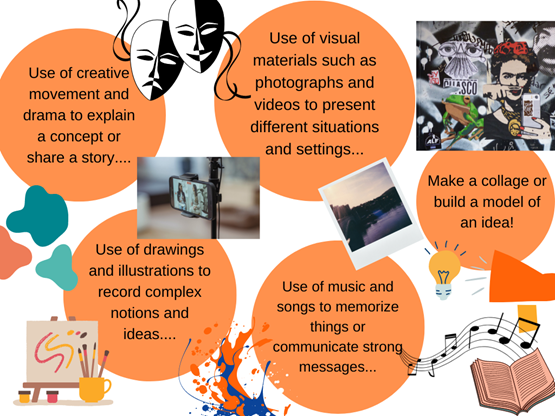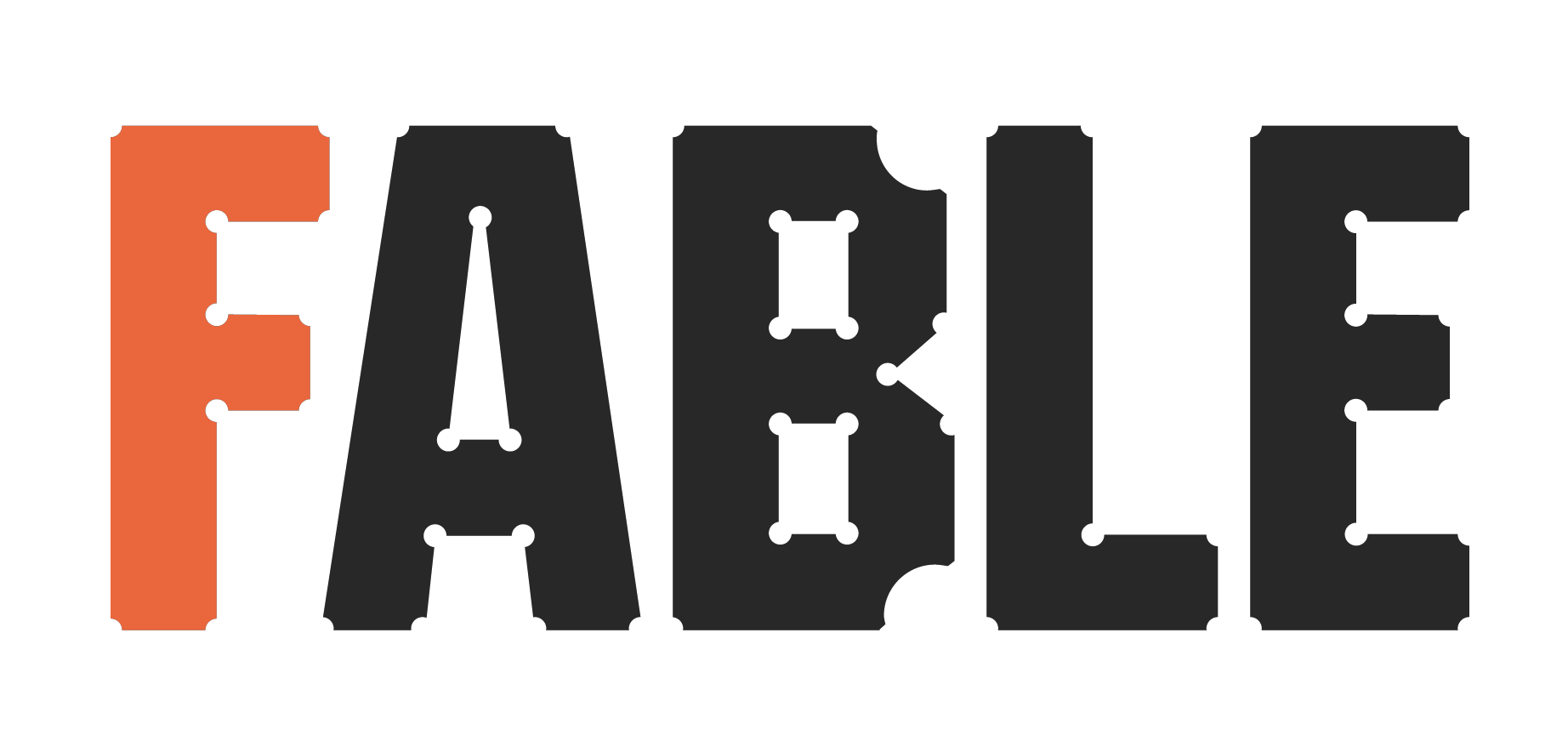Part 2: Methodologies for art-based learning (continued)
Methodologies for art-based learning
Simple tips for incorporating creativity in different learning contexts!

Design Thinking for dealing with youth needs
Design thinking is a creative, hands-on and user-centered process. It can develop innovative, meaningful and effective solutions by allowing deep needs analysis and experimentation. You can easily use this method to design a new product/service or a policy that addresses youth needs. Youth workers can use this method to identify actions that could be taken for the well-being of the young people.
We have identified six steps that could be implemented in this method: a. Empathize, b. Define, c. Ideate, d. Prototype, e. Test/Evaluate, f. Implement.
a. To empathize: In this step, youth workers aim to gain an empathetic understanding of the needs of the young people. They can use different research methods, implement questionnaires, consult experts, organize focus groups, etc. They can also directly engage with and observe young people’s activities in order to have a deeper and personal understanding of the youth issues.
b. To define: Based on the collected information and observations, youth workers should synthesize their findings to define the issue at stake. In this step, it is important to articulate the issue in a way that describes what young people need and not what you will need to do to address young people’s needs. For example, you shouldn’t say that “we need to create more public spaces”. You should say “young people need more public spaces”.
c. To ideate: In this step, you start generating ideas to solve the issue at stake. You can use different kinds of ideation techniques to analyze the issue and name different ideas. Quantity matters here. So, don’t be afraid to think outside of the box! In fact, this is what is needed.
Brainstorming is the most typical way to collect many ideas but there are more arts-based methods, such as Mind Mapping and Sketchstorming. You may develop a visual story of the problem to illustrate a situation’s dynamics. The Problem/Solution tree method is also very typical and helpful. You can also use role-playing to embody different scenarios and solutions. And of course, you may directly ask young people’s options and receive helpful feedback and insights. Finally, a more provocative approach would be to challenge the beliefs and assumptions about the problems. An easy technique is to imagine alternatives using the question “what if…”.
d. To prototype: This step aims to find the best possible solution to a certain problem that has been defined from the previous phases. It is a very experimental and hands-on step where the youth workers could build prototypes of the suggested solutions. Creativity and imagination are important elements for this step. Youth workers could use gamification techniques, make models of their intervention with building blocks, and collage using different materials, from scraps of papers to other non-used materials. Having such a concrete result has an empowering benefit for those involved in this process.
e. To test/evaluate: One by one, youth workers can test each prototype, test it to see if it could be accepted, improved or rejected based on the young people’s experience and feedback. Youth workers can then proceed with further iterations and make alterations and refinements to rule out alternative solutions. It will help them understand better the attitudes towards the different proposals and the needs of the young people. This try and error step can be liberating in a sense that there is no right or wrong and there is space for making “mistakes” and continues with improvements. Testing can also take different forms. Apart from actually using the prototype, you could use more creative methods to experience the outcomes. They could use theatrical expression and improvisation using multiple scenarios to test the assumptions made in the beginning of the design thinking process and uncover the different consequences and impact.
f. To implement: After evaluating the possible alternatives and making the relevant modifications, youth workers could choose to suggest the best solutions for implementation and future scaling-up if the conditions allow it.
What we have seen with this process is that we can encompass different creative approaches and techniques in the steps. In the presented process, youth workers were the designers and those who had the task to provide solutions for the young people. The process, however, can be used by the young people themselves as agents of change. The following section explains how and why design thinking should be rethinked and modified accordingly.

From Design Thinking to Participatory Design
Although design thinking could be a promising process to find solutions to problems and, among other things, deal with the needs of the young people, it has been criticized that it does not fulfill its claims.
According to Lucy Kimbell (2011, 2012), design thinking relies on dualism between thinking and knowing, and acting in the world, rather than acknowledging the situated, embodied work of design thinking in practice. Furthermore, several different types of professionals and practitioners do design work, not just “designers”. Design thinking might ignore the diversity of creative practices and institutions which are historically situated. Who designs, what, where, for what? Who facilitates or supports the implementation of the design? This makes it questionable to generalize about a unified design thinking exhibited across different settings, contexts, even localities. Finally, it reinforces the privileged position of the “designer”, although empathetic, as the main agent in designing without directly involving the “users” but simply researching their needs.
Α starting point for practitioners, i.e. youth workers, is to be in the world and recognise their relation to other social actors including artifacts and other social practices and institutions. It is important to explore how political, socio-cultural, and economic developments shape and influence the steps of designing thinking.
However, to practice more inclusive and socially innovative youth work, processes should be more participatory-friendly, in a sense that young people are actively engaged and participating in the design of the solutions. Hence, our proposal would be to use the steps of the design thinking but reframe them in order to apply them with the young people not just for the young people. There are many benefits from using this approach. Young people research and analyze content and contexts more critically, can better organize and express their ideas, build stronger arguments, collaborate and propose collective solutions, become more responsible are only some of them.
In the following video, we present an example of an initiative that uses a more participatory approach.
Youth Pool
- Visual Arts Learning Activity Types by Camille Dempsey, Judi Harris, and Mark Hofer is licensed under a Creative Commons Attribution-Noncommerical-No Derivative Works 3.0 United States License. Based on a work at activitytypes.wm.edu
- Open Educational Resource on Art Therapy Toolkit – ARTCOM, coordinated by CESIE, co-funded by Erasmus+ programme
- Art for intercultural dialogue Toolkit – ARTOOLKIT, published by CEIPES, funded by European Youth Foundation of Council of Europe
- Robert Bosch Stiftung, How Can Art and Activism Work Together? | Talk with Kumi Naidoo, Olafur Eliasson and Molly Fannon, YouTube, BoschStiftung, April 20, 2022, 1h 9 mins 53 secs. https://www.youtube.com/watch?v=Nwt0PwV-PpY
- The Changing Story: Digital Stories That Participate in Transforming Teaching & Learning. L. Buturian with S. Andre and T. Nechodomu, College of Education and Human Development (CEHD), January 4, 2016.
- Eisner, E. W. (2002). The arts and the creation of mind. Yale University Press.
- Møller-Skau, M., & Lindstøl, F. (2022). Arts-based teaching and learning in teacher education:“Crystallizing” student teachers’ learning outcomes through a systematic literature review. Teaching and Teacher Education, 109, 103545.
- Kimbell, L. (2011). Rethinking design thinking: Part I. Design and culture, 3(3), 285-306.
- Rikke Friis Dam, 5 Stages in the Design Thinking Process, June 2021, https://www.interaction-design.org/literature/article/5-stages-in-the-design-thinking-process (last accessed: 6 June 2022)
Evaluation
Your task to pass this module is to create your own arts-based activity!
Mention a title, the objectives, the preparation on behalf of the facilitator(s) or/and the participants, the estimated duration, the activity description and the required materials. It does not need to be an extended activity that has different steps and phases. It could be a smaller scale activity, even a game. The aim is to use the knowledge you gathered in this module to experiment and try developing your own activities inspired by arts-based methodology.
Part 1: Introduction to non-formal/ informal education
Part 3: Methodologies for creative tinkering

